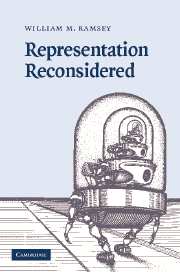Book contents
- Frontmatter
- Contents
- List of figures
- Preface
- 1 Demands on a representational theory
- 2 Representation in classical computational theories: the Standard Interpretation and its problems
- 3 Two notions of representation in the classical computational framework
- 4 The receptor notion and its problems
- 5 Tacit representation and its problems
- 6 Where is the representational paradigm headed?
- References
- Index
2 - Representation in classical computational theories: the Standard Interpretation and its problems
Published online by Cambridge University Press: 12 November 2009
- Frontmatter
- Contents
- List of figures
- Preface
- 1 Demands on a representational theory
- 2 Representation in classical computational theories: the Standard Interpretation and its problems
- 3 Two notions of representation in the classical computational framework
- 4 The receptor notion and its problems
- 5 Tacit representation and its problems
- 6 Where is the representational paradigm headed?
- References
- Index
Summary
In this chapter I reveal what I take to be a popular set of assumptions and tacit attitudes about the explanatory role of representation in the CCTC. I'll suggest that these assumptions and attitudes collectively give rise to an outlook on representation that amounts to a sort of merger between classical computational theory and folk psychology. In other words, the way researchers and especially philosophers have come to regard the importance of representations in the CCTC has been largely determined by their understanding of beliefs and other commonsense notions. This has led to a way of thinking about computational representations that suggests their primary explanatory function is to provide a scientific home for folk notions of mental representations. In other words, symbolic representations in the CCTC have come to be viewed as the scientific analogues for beliefs, desires, ideas, thoughts, and similar representational posits of folk psychology.
This perceived connection between computational representation and folk psychology comprises what I will refer to as the “Standard Interpretation” of the CCTC. While few authors have explicitly stated the Standard Interpretation, at least not in the manner in which it will be presented here, it (or some version of it) has nevertheless played a significant role in shaping the way many people think about the CCTC. After spelling out what I think the Standard Interpretation involves, I'll try to show that it leads us down a path where, despite various claims to the contrary, we wind up wondering whether the symbols of classical models should be viewed as representations at all.
- Type
- Chapter
- Information
- Representation Reconsidered , pp. 38 - 66Publisher: Cambridge University PressPrint publication year: 2007



